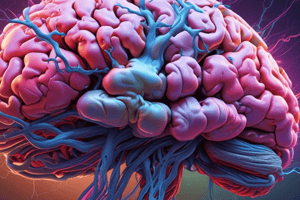Podcast
Questions and Answers
What is cerebral angiography?
What is cerebral angiography?
- A technique to visualize the brain in three dimensions
- A computer-assisted x-ray procedure
- A contrast x-ray technique that uses a radio-opaque dye (correct)
- A conventional x-ray technique
What is the purpose of a cerebral angiogram?
What is the purpose of a cerebral angiogram?
- To localize vascular damage and indicate the location of a tumor (correct)
- To visualize the brain using conventional x-ray photography
- To enhance contrast during x-ray photography
- To generate a CT scan of the brain
What is computed tomography (CT)?
What is computed tomography (CT)?
- A computer-assisted x-ray procedure to visualize the brain (correct)
- A contrast x-ray technique that uses a radio-opaque dye
- A technique to generate a three-dimensional representation of the brain
- A conventional x-ray technique
Flashcards
Cerebral angiography
Cerebral angiography
A contrast x-ray technique using a radio-opaque dye to view blood vessels in the brain.
Cerebral angiogram purpose
Cerebral angiogram purpose
Locates vascular damage and tumor sites in the brain.
Computed Tomography (CT)
Computed Tomography (CT)
Uses x-rays and a computer to create detailed images of brain structures.
Study Notes
- Conventional x-ray photography is not useful for visualizing the brain.
- Contrast x-ray techniques involve injecting a substance that absorbs x-rays either less or more than the surrounding tissue to heighten contrast during x-ray photography.
- Cerebral angiography is a contrast x-ray technique that uses the infusion of a radio-opaque dye into a cerebral artery to visualize the cerebral circulatory system during x-ray photography.
- Cerebral angiograms are useful for localizing vascular damage and indicating the location of a tumor.
- Computed tomography (CT) is a computer-assisted x-ray procedure that can be used to visualize the brain and other internal structures of the living body.
- During cerebral CT, the patient lies with their head positioned in the center of a large cylinder, and an x-ray tube and detector rotate around the head to take individual x-ray photographs.
- The meager information in each x-ray photograph is combined by a computer to generate a CT scan of one horizontal section of the brain.
- Scans of eight or nine horizontal brain sections are typically obtained from a patient during cerebral CT.
- The combination of scans can provide three-dimensional representations of the brain.
- These techniques revolutionized the study of the living human brain in the early 1970s.
Studying That Suits You
Use AI to generate personalized quizzes and flashcards to suit your learning preferences.





